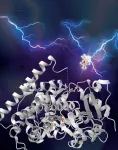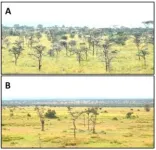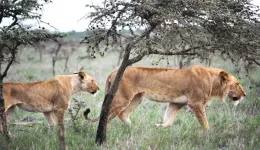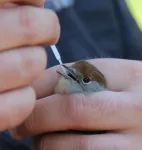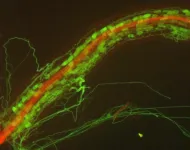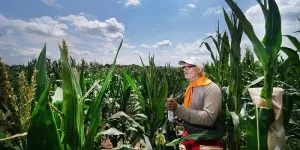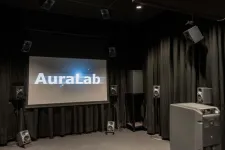For the first time, scientists have engineered an enzyme that can break stubborn man-made bonds between silicon and carbon that exist in widely used chemicals known as siloxanes, or silicones. The discovery is a first step toward rendering the chemicals, which can linger in the environment, biodegradable.
"Nature is an amazing chemist, and her repertoire now includes breaking bonds in siloxanes previously thought to evade attack by living organisms," says Frances Arnold, the Linus Pauling Professor of Chemical Engineering, Bioengineering and Biochemistry at Caltech and winner of the 2018 Nobel Prize in Chemistry for her pioneering work in directed evolution, a method for engineering enzymes and other proteins using the principles of artificial selection. Arnold and her colleagues, including Dimitris (Dimi) Katsoulis of Michigan-based Dow Inc. used directed evolution to create the new silicon–carbon bond-cleaving enzyme. The results are published in the January 26 issue of the journal Science.
The researchers say that while practical uses for their engineered enzyme could still be a decade away or more, its development opens the possibility that siloxanes could one day be degraded biologically. "For example, natural organisms could evolve in siloxane-rich environments to catalyze a similar reaction, or further improved versions of laboratory-evolved enzymes such as this one could possibly be used to treat siloxane contaminants in wastewater," Arnold says.
Katsoulis explains that nature doesn't use silicon–carbon bonds, "but we do and have been for about 80 years. The volatile nature of some of these compounds warrants health and environmental research to properly understand the degradation mechanisms of these materials in the environment.”
Siloxane chemicals can be found in countless products, including those used in household cleaning, personal care, and the automotive, construction, electronics, and aerospace industries. The compounds’ chemical backbone is made of silicon–oxygen bonds, while carbon-containing groups, often methyl, are attached to the silicon atoms. "The silicon–oxygen backbone gives the polymer an inorganic-like character while the silicon–methyl groups give the polymer organic-like characteristics. Thus, these polymers have unique material properties, such as high thermal and oxidative stability, low surface tension, and high backbone flexibility among others," Katsoulis says.
Siloxanes are believed to persist in the environment for days to months, and, therefore, ongoing research aims to provide greater scientific understanding of the health and environmental safety of silicone materials. The chemicals naturally start to fragment into smaller pieces, especially in soil or aquatic environments, and those fragments become volatile or escape into the air, where they undergo degradation by reacting with free radicals in the atmosphere. Of all the bonds in siloxanes, the silicon–carbon bonds are the slowest to break down.
Katsoulis approached Arnold to collaborate on efforts to speed up siloxane degradation after he read about her lab's work in coaxing nature to produce silicon–carbon bonds. In 2016, Arnold and her colleagues used directed evolution to engineer a bacterial protein called cytochrome c to form silicon–carbon bonds, a process that does not occur in nature. "We decided to get nature to do what only chemists could do—only better," Arnold said in a Caltech news release. The research demonstrated that biology could make these bonds in ways that are more environmentally friendly than those traditionally used by chemists.
In the new study, the researchers wanted to find ways to break the bonds rather than create them. The scientists used directed evolution to evolve a bacterial enzyme called cytochrome P450. Directed evolution is similar to breeding dogs or horses in that the process is designed to bring out desired traits. The researchers first identified a variant of cytochrome P450 in their collection of enzymes that had a very weak ability to break silicon–carbon bonds in so-called linear and cyclic volatile methylsiloxanes, a common subgroup of the siloxane family.
They mutated the DNA of the cytochrome P450 and tested the new variant enzymes. The best performers were then mutated again, and the testing was repeated until the enzyme was active enough to enable the researchers to identify the products of the reaction and study the mechanism by which the enzyme works.
"Evolving enzymes to break these bonds in siloxanes presented unique hurdles. With directed evolution, we must evaluate hundreds of new enzymes in parallel to identify a few enzyme variants with improved activity," says Tyler Fulton (PhD '22), co-lead author of the study and a postdoctoral scholar at Caltech in Arnold's lab. One challenge involved the siloxane molecules leaching plastic components from the 96-well plates used to screen the variants. To solve the problem, the team created new plates made from common lab supplies.
"Another challenge was finding the starting enzyme for the directed evolution process, one with even just a tiny amount of the desired activity," Arnold says. "We found it in our unique collection of cytochrome P450s evolved in the laboratory for other types of new-to-nature silicon chemistry."
The final improved enzyme does not directly cleave the silicon–carbon bond but rather oxidizes a methyl group in the siloxanes in two sequential steps. Basically, this means that two carbon–hydrogen bonds are replaced with carbon–oxygen bonds, and this change allows the silicon–carbon bond to break more readily.
The research draws parallels to studies involving a plastic-eating enzyme, explains Fulton, referring to a polyethylene terephthalate (PET)-degrading enzyme discovered in the bacteria Ideonella sakaiensis in 2016 by a different group of researchers. "While the PET-degrading enzyme was discovered by nature rather than by engineers, that enzyme inspired other innovations that are finally coming to fruition for plastic degradation. We hope this demonstration will similarly inspire further work to help break down siloxane compounds," he says.
The Science paper titled "Directed evolution of enzymatic silicon–carbon bond cleavage in siloxanes" was funded by Dow’s University Partnership Initiative and the National Science Foundation. Other Caltech authors include co-lead author Nicholas Sarai (PhD '23), as well as graduate student Ryen L. O'Meara, Kadina E. Johnston (PhD '23), and Arnold lab manager Sabine Brinkmann-Chen. Other Dow authors include Ryan R. Maar, Ron E. Tecklenburg, John M. Roberts, and Jordan C. T. Reddel.
END
